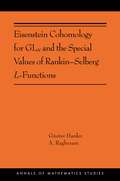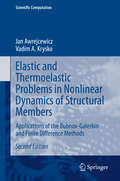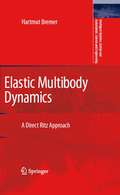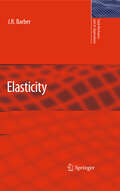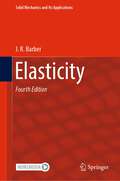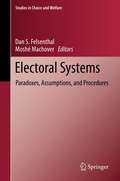- Table View
- List View
Einstieg in die Wirtschaftsmathematik (Studienbücher Wirtschaftsmathematik)
by Bernd Luderer Uwe WürkerDieses Lehrbuch vermittelt Studierenden der Wirtschaftswissenschaften die allgemeinen mathematischen Grundlagen sowie die wichtigsten Begriffe und Ideen aus Analysis, Linearer Algebra, Linearer Optimierung und Finanzmathematik.Es legt besonderen Wert auf eine verständliche Darlegung und bietet ausführlich diskutierte Beispiele, Aufgaben und Lösungen zu allgemeinen mathematischen Grundlagen sowie zahlreiche Anwendungsbeispiele und Übungsaufgaben mit wirtschaftswissenschaftlichem Bezug. Darüber hinaus wird die Darstellung ergänzt durch wichtige Formeln, Übersichten und Hinweise.Für die vorliegende 10. Auflage wurden 180 digitale Flashcards ergänzt, mit denen der eigene Lernerfolg in der zugehörigen App oder im Browser überprüft werden kann. Im Buch selbst wurden kleine Korrekturen und Aktualisierungen vorgenommen.Eine große Auswahl an Übungsaufgaben zu den hier behandelten Inhalten sowie weitere Flashcards finden sich im passenden Arbeits- und Übungsbuch Wirtschaftsmathematik (Luderer/Würker/Kalkschmid-Paape). Lehr- und Arbeitsbuch sind inhaltlich aufeinander abgestimmt, können aber auch ganz unabhängig voneinander verwendet werden.
Einstieg in die Wirtschaftsmathematik
by Uwe Würker6 mathematische Lösungsmethoden bei der Untersuchung der ihn interessieren den Fragen helfen können. Dieses Anliegen wird im Buch dadurch realisiert, daß die behandelten mathematischen Themen an vielen Anwendungsbeispie len illustriert werden und daß großer Wert auf die Interpretation der erzielten Ergebnisse gelegt wird. Die Darlegungen des Buches berücksichtigen natürlich, daß ein Student im l. Semester noch kein fertig ausgebildeter Wirtschaftswissenschaftler ist. Deshalb werden sehr spezielle Fachtermini vermieden. Zur Anregung der selbständi gen Beschäftigung mit dem behandelten Stoff werden dafür eine große Zahl an Übungsaufgaben gestellt, von denen in der Regel auch die Lösungen im Anhang zu finden sind. Schließlich ist die Vielzahl im Buch enthaltener Abbildungen dazu gedacht, das Vorstellungsvermögen anzuregen und zu verbessern. Das vorliegende Lehrbuch vereint gewissermaßen drei Bücher in einem: einen Vorkurs zum Erwerb oder zur Festigung von Abiturkenntnissen, den ei gentlichen Grundkurs Mathematik für Wirtschaftswissenschaftler, der die Ge biete Lineare Algebra, Lineare Optimierung und Analysis mehrerer Veränder licher umfaßt, sowie eine relativ umfangreiche Einführung in die Finanzma thematik. Nicht unerwähnt sollte bleiben, daß das Buch so angelegt ist, daß es sich auch vorzüglich zum Selbststudium eignet. Erfreulicherweise stieß die erste Ausgabe auf eine rege Nachfrage, so daß be reits nach relativ kurzer Zeit eine neue Auflage notwendig wurde. Wesentliche inhaltliche Änderungen erschienen uns dabei nicht erforderlich, jedoch haben wir das gesamte Buch einer nochmaligen kritischen Durchsicht unterzogen und einige Schreibfehler korrigiert.
Einstieg in die Wirtschaftsmathematik (Teubner Studienbücher Mathematik)
by Uwe WürkerMathematische Methoden sind integraler Bestandteil der verschiedensten wirtschaftswissenschaftlichen Gebiete. Eine sichere Beherrschung der allgemeinen mathematischen Grundlagen sowie der wichtigsten Begriffe und Ideen aus Analysis, Linearer Algebra, Linearer Optimierung und Finanzmathematik sind deshalb für Sozial- und Wirtschaftswissenschaftler unabdingbar. Der Vermittlung dieser Kenntnisse dient dieses Buch, in dem besonderer Wert auf eine verständliche Darlegung sowie zahlreiche Anwendungsbeispiele und Übungsaufgaben mit wirtschaftswissenschaftlichem Bezug gelegt wird.
Einstieg in stochastische Prozesse: Grundlagen und Anwendungen mit vielen Übungen, Lösungen und Videos
by Thorsten Imkamp Sabrina ProßDieses Lehrbuch führt in das faszinierende Gebiet der stochastischen Prozesse ein, indem es die entsprechenden Inhalte verständlich darstellt und sie mit Anwendungen aus den Natur- und Ingenieurwissenschaften verbindet. Es enthält zahlreiche vollständig durchgerechnete Beispiele, in denen bei Bedarf die Softwaretools MATLAB und Mathematica eingesetzt werden. Mithilfe von sowohl theoretischen als auch anwendungsorientierten Übungsaufgaben können die vorgestellten Verfahren erlernt und das Verständnis vertieft werden. Für fast alle Aufgaben werden vollständige Lösungswege im Buch oder im zugehörigen YouTube-Kanal der Autoren präsentiert. Zur Aneignung und Festigung der Inhalte erhalten Leser des Buchs zudem passende Lernfragen, auf die sie in der Springer-Flashcards-App zugreifen können. Das Buch bietet somit ein stimmiges Gesamtpaket und eignet sich hervorragend zum Selbststudium. Nach einem Überblick über die notwendigen mathematischen Grundlagen erfolgt eine ausführliche und mit vielen Beispielen gestützte Einführung in Theorie und Praxis zeitdiskreter und zeitstetiger Markoff-Ketten, sowie Varianten von Markoff-Prozessen – insbesondere Wiener-Prozesse zur Modellierung der Brown‘schen Bewegung. Danach erfolgen systematische Einführungen in Martingale, Warteschlangen und die Zuverlässigkeitstheorie. Monte-Carlo-Simulationen finden in einem eigenen Kapitel Platz, das neben einer ausführlichen Beschreibung der Methode auch Spielraum für eigene Experimente mit den dort vorgestellten Programmen bietet. Eine Einführung in die Grundlagen der (stochastischen) Petri-Netze und ein leicht zugänglicher Einstieg in die stochastische Analysis (stochastische Integrale, stochastische Differentialgleichungen) runden das Buch ab.
Eisenstein Cohomology for GLN and the Special Values of Rankin–Selberg L-Functions: (AMS-203) (Annals of Mathematics Studies #203)
by Anantharam Raghuram Günter HarderThis book studies the interplay between the geometry and topology of locally symmetric spaces, and the arithmetic aspects of the special values of L-functions.The authors study the cohomology of locally symmetric spaces for GL(N) where the cohomology groups are with coefficients in a local system attached to a finite-dimensional algebraic representation of GL(N). The image of the global cohomology in the cohomology of the Borel–Serre boundary is called Eisenstein cohomology, since at a transcendental level the cohomology classes may be described in terms of Eisenstein series and induced representations. However, because the groups are sheaf-theoretically defined, one can control their rationality and even integrality properties. A celebrated theorem by Langlands describes the constant term of an Eisenstein series in terms of automorphic L-functions. A cohomological interpretation of this theorem in terms of maps in Eisenstein cohomology allows the authors to study the rationality properties of the special values of Rankin–Selberg L-functions for GL(n) x GL(m), where n + m = N. The authors carry through the entire program with an eye toward generalizations.This book should be of interest to advanced graduate students and researchers interested in number theory, automorphic forms, representation theory, and the cohomology of arithmetic groups.
Eisenstein Series and Applications (Progress in Mathematics #258)
by Wee Teck Gan Stephen S. Kudla Yuri TschinkelEisenstein series are an essential ingredient in the spectral theory of automorphic forms and an important tool in the theory of L-functions. They have also been exploited extensively by number theorists for many arithmetic purposes. Bringing together contributions from areas which do not usually interact with each other, this volume introduces diverse users of Eisenstein series to a variety of important applications. With this juxtaposition of perspectives, the reader obtains deeper insights into the arithmetic of Eisenstein series. The central theme of the exposition focuses on the common structural properties of Eisenstein series occurring in many related applications.
Eisensteinkohomologie und die Konstruktion gemischter Motive (Lecture Notes in Mathematics #1562)
by Günter HarderElastic and Thermoelastic Problems in Nonlinear Dynamics of Structural Members: Applications of the Bubnov-Galerkin and Finite Difference Methods (Scientific Computation)
by Jan Awrejcewicz Vadim A. KryskoFrom the reviews: "A unique feature of this book is the nice blend of engineering vividness and mathematical rigour. [...] The authors are to be congratulated for their valuable contribution to the literature in the area of theoretical thermoelasticity and vibration of plates." Journal of Sound and Vibration
An Elastic Model for Volcanology (Lecture Notes in Geosystems Mathematics and Computing)
by Andrea AspriThis monograph presents a rigorous mathematical framework for a linear elastic model arising from volcanology that explains deformation effects generated by inflating or deflating magma chambers in the Earth’s interior. From a mathematical perspective, these modeling assumptions manifest as a boundary value problem that has long been known by researchers in volcanology, but has not, until now, been given a thorough mathematical treatment. This mathematical study gives an explicit formula for the solution of the boundary value problem which generalizes the few well-known, explicit solutions found in geophysics literature. Using two distinct analytical approaches—one involving weighted Sobolev spaces, and the other using single and double layer potentials—the well-posedness of the elastic model is proven. An Elastic Model for Volcanology will be of particular interest to mathematicians researching inverse problems, as well as geophysicists studying volcanology.
Elastic Multibody Dynamics: A Direct Ritz Approach (Intelligent Systems, Control and Automation: Science and Engineering #35)
by Hartmut Bremer1. Background This textbook is an introduction to and exploration of a number of core topics in the ?eld of applied mechanics. Mechanics, in both its theoretical and applied contexts, is, like all scienti?c endeavors, a human construct. It re?ects the personalities, thoughts, errors, and successes of its creators. We therefore provide some personal information about each of these individuals when their names arise for the ?rst time in this book. This should enable the reader to piece together a cultural-historical picture of the ?eld s origins and development. This does not mean that we are writing history. Nevertheless, some remarks putting individuals and ideas in context are necessary in order to make clear what we are speaking about – and what we are not speaking about. At the end of the 19th century, technical universities were established eve- where in Europe in an almost euphoric manner. But the practice of technical mechanics itself, as one of the basics of technical development, was in a desolate state, due largely to the refusal of its practitioners to recognize the in?uence of kinetics on motion. They were correct to the extend that then current mechanical systems moved with small velocities where kinetics does not play a signi?cant role. But they had failed to keep up with developments in the science underlying their craft and were unable to keep pace with the speeds of such systems as the steam engine.
Elastic/Plastic Discs Under Plane Stress Conditions (SpringerBriefs in Applied Sciences and Technology)
by Sergey AlexandrovThis Volume presents a unified approach to calculate the plane stress distribution of stress and strain in thin elastic/plastic discs subject to various loading conditions. There is a vast amount of literature on analytical and semi-analytical solutions for such discs obeying Tresca’s yield criterion and its associated flow rule. On the other hand, most of analytical and semi-analytical solutions for Mises yield criterion are based on the deformation theory of plasticity. A distinguished feature of the solutions given in the present volume is that the flow theory of plasticity and Mises yield criterion are adopted. The solutions are semi-analytical in the sense that numerical methods are only necessary to evaluate ordinary integrals and solve transcendental equations. The book shows that under certain conditions solutions based on the deformation and flow theories of plasticity coincide. All the solutions are illustrated with numerical examples. The goal of the book is to provide the reader with a vision and an insight into the problems of analysis and design of elastic/plastic discs. The limitations and the applicability of solutions are emphasized. The book is written for engineers, graduate students and researchers interested in the development of techniques for analysis and design of thin elastic/plastic discs.
Elastic Waves: High Frequency Theory (Chapman & Hall/CRC Monographs and Research Notes in Mathematics)
by Vassily Babich Aleksei KiselevElastic Waves: High Frequency Theory is concerned with mathematical aspects of the theory of high-frequency elastic waves, which is based on the ray method. The foundations of elastodynamics are presented along with the basic theory of plane and spherical waves. The ray method is then described in considerable detail for bulk waves in isotropic and anisotropic media, and also for the Rayleigh waves on the surface of inhomogeneous anisotropic elastic solids. Much attention is paid to analysis of higher-order terms and to generation of waves in inhomogeneous media. The aim of the book is to present a clear, systematic description of the ray method, and at the same time to emphasize its mathematical beauty. Luckily, this beauty is usually not accompanied by complexity and mathematical ornateness.
Elastic Waves: High Frequency Theory (Chapman & Hall/CRC Monographs and Research Notes in Mathematics)
by Vassily Babich Aleksei KiselevElastic Waves: High Frequency Theory is concerned with mathematical aspects of the theory of high-frequency elastic waves, which is based on the ray method. The foundations of elastodynamics are presented along with the basic theory of plane and spherical waves. The ray method is then described in considerable detail for bulk waves in isotropic and anisotropic media, and also for the Rayleigh waves on the surface of inhomogeneous anisotropic elastic solids. Much attention is paid to analysis of higher-order terms and to generation of waves in inhomogeneous media. The aim of the book is to present a clear, systematic description of the ray method, and at the same time to emphasize its mathematical beauty. Luckily, this beauty is usually not accompanied by complexity and mathematical ornateness.
Elasticity (Solid Mechanics and Its Applications #172)
by J. R. BarberThe subject of Elasticity can be approached from several points of view, - pending on whether the practitioner is principally interested in the mat- matical structure of the subject or in its use in engineering applications and, in the latter case, whether essentially numerical or analytical methods are envisaged as the solution method. My ?rst introduction to the subject was in response to a need for information about a speci?c problem in Tribology. As a practising Engineer with a background only in elementary Mechanics of - terials, I approached that problem initially using the concepts of concentrated forces and superposition. Today, with a rather more extensive knowledge of analytical techniques in Elasticity, I still ?nd it helpful to go back to these roots in the elementary theory and think through a problem physically as well as mathematically, whenever some new and unexpected feature presents di?culties in research. This way of thinking will be found to permeate this book. My engineering background will also reveal itself in a tendency to work examples through to ?nal expressions for stresses and displacements, rather than leave the derivation at a point where the remaining manipulations would be mathematically routine. The ?rst edition of this book, published in 1992, was based on a one semester graduate course on Linear Elasticity that I have taught at the U- versity of Michigan since 1983.
Elasticity (Solid Mechanics and Its Applications #172)
by J. R. BarberThis book emphasizes engineering applications of elasticity. This is a first-year graduate textbook in linear elasticity. It is written with the practical engineering reader in mind, dependence on previous knowledge of solid mechanics, continuum mechanics or mathematics being minimized. Examples are generally worked through to final expressions for the stress and displacement fields in order to explore the engineering consequences of the results. This 4th edition presents new and revised material, notably on the Eshelby inclusion problem and anisotropic elasticity.The topics covered are chosen with a view to modern research applications in fracture mechanics, composite materials, tribology and numerical methods. Thus, significant attention is given to crack and contact problems, problems involving interfaces between dissimilar media, thermoelasticity, singular asymptotic stress fields and three-dimensional problems.
Elastoplasticity Theory (Lecture Notes in Applied and Computational Mechanics #42)
by Koichi HashiguchiContents Recent advancements in the performance of industrial products and structures are quite intense. Consequently, mechanical design of high accuracy is necessary to enhance their mechanical performance, strength and durability. The basis for their mechanical design can be provided through elastoplastic deformation analyses. For that reason, industrial engineers in the fields of mechanical, civil, architec- ral, aerospace engineering, etc. must learn pertinent knowledge relevant to elas- plasticity. Numerous books about elastoplasticity have been published since “Mathema- cal Theory of Plasticity”, the notable book of R. Hill (1950), was written in the middle of the last century. That and similar books mainly address conventional plasticity models on the premise that the interior of a yield surface is an elastic domain. However, conventional plasticity models are applicable to the prediction of monotonic loading behavior, but are inapplicable to prediction of deformation behavior of machinery subjected to cyclic loading and civil or architectural str- tures subjected to earthquakes. Elastoplasticity has developed to predict defor- tion behavior under cyclic loading and non-proportional loading and to describe nonlocal, finite and rate-dependent deformation behavior.
Elder Abuse in the LGBTQ2SA+ Community: The Impact of Homophobia and Transphobia (International Perspectives on Aging #37)
by Claire Robson Jen Marchbank Gloria Gutman Makaela PrenticeThis book describes and analyzes the lived experience of elder abuse from the queer community. It discusses the experiences by transwomen, gay men and lesbians of financial abuse, physical and sexual abuse, homophobic abuse, and neglect within partner relationships, residential care, in home care, and religious organizations. Queer and trans elders have been described as ‘The Silent Generation’, since they have lived through times when their sexual and gender identities were criminalized and pathologized. The book shows that they are far more at risk to suffer abuse and neglect by those they should be able to trust, since they are more likely to have encountered all key risk factors, such as isolation, previous abuse and trauma, and mistrust of the health care system. Their vulnerability has been overlooked and this book addresses that gap. As such, this book provides a great resource to anyone working with elders, including medical professionals, care providers, police, counsellors, and policy makers.
Eldercare Labor Demand in China and Coping Strategies
by Yali ZhuThis book employs Markov models and propensity score matching methods to analyze the demand for elderly care labor, utilizing data from the China Longitudinal Healthy Longevity Survey (CLHLS) and World Population Prospects 2022 (United Nations, 2022). The model predicts the health transferring scenario among the aging population firstly, and then the demand for elderly care labor from 2022 to 2058 under a fixed care time demand scenario according to 8-hour working system, as well as national and provincial regulations on caregiver-carereceiver ratios. The accelerated aging process and rapid increase in the younger elderly population will result in a rapid increase in the demand for elderly care labor for the healthy elderly until about 2042, with a 1.5-fold increase. This is followed by accelerated growth in the demand for elderly care labor for the impaired and dysfunctional aging population. Over time, the supply of older adults without care will gradually increase, nearly doubling by 2058 compared to 2022. It is recommended that on the one hand, eldercare labor demand in China can be reduced from the origin by improving the health of the population; and on the other hand, the effective supply of elderly care be expanded by building a modern care service system, improving relevant policies, integrating care resources, and innovating the supply model.
Elderly Health Services and Remote Health Monitoring (SpringerBriefs in Applied Sciences and Technology)
by Lumin Chen Yihao Li Lina Han Liang Yuan Yuxiang Sun Xiaolu TangThis book focuses on typical health services and remote monitoring methods, such as visual recognition and deep learning. Chiefly addressing the design and simulation of rehabilitation devices, and the evaluation of their effects on various diseases, it offers a valuable resource for professional researchers and graduate students in the fields of elderly medicine, signal processing, and rehabilitation.
eLearning in Unternehmen: Neue Wege für Training und Weiterbildung
by Michael Dowling Jörg EberspächerSeit langem sind die Möglichkeiten einer computer- und netzgestützten Aus- und Weiterbildung Gegenstand von vielfältigen Erörterungen und Versuchen in Wissenschaft und Praxis. Aber erst seit wenigen Jahren, vor allem mit dem Aufkommen leistungsfähiger Intra- und Extranets, zugehöriger Tools sowie geeigneter didaktischer und organisatorischer Konzepte gibt es Erfahrungen auf breiterer Basis, insbesondere auch mit Blick auf die Bedeutung von eLearning für die Entwicklung von Unternehmen. In praktischen Beispielen zeigt sich der erhebliche wirtschaftliche Nutzen, der durch angemessene eLearning-Lösungen für Qualifizierung und Training in Unternehmen erzeugt werden kann. Der Münchner Kreis hat die damit verbundenen Erkenntnisse und Perspektiven sowohl grundsätzlich als auch entlang von Fallbeispielen in Diskussion mit namhaften Experten aufgearbeitet. Dieses Buch enthält die Ergebnisse der Konferenz.
Elections and Exit Polling
by Fritz J. Scheuren Wendy Alvey"An understanding of the relationship between the product and the process in election polling is often lost. This edited volume unites ideas and researchers, with quality playing the central role." —J. Michael Brick, PhD, Director of the Survey Methods Unit, Westat, Inc. Elections and Exit Polling is a truly unique examination of the specialized surveys that are currently used to track and collect data on elections and voter preferences. Employing modern research from the past decade and a series of interviews with famed American pollster Warren Mitofsky (1934-2006), this volume provides a relevant and groundbreaking look at the key statistical techniques and survey methods for measuring voter preferences worldwide. Drawing on the most current studies on pre-election and exit polling, this book outlines improvements that have developed in recent years and the results of their implementation. Coverage begins with an introduction to exit polling and a basic overview of its history, structure, limitations, and applications. Subsequent chapters focus on the use of exit polling in the United States election cycles from 2000–2006 and the problems that were encountered by both pollsters and the everyday voter, such as how to validate official vote count, confidentiality, new voting methods, and continuing data quality concerns. The text goes on to explore the presence of these issues in international politics, with examples and case studies of elections from Europe, Asia, and the Middle East. Finally, looking to the upcoming 2008 U.S. presidential election, the discussion concludes with predictions and recommendations on how to gather more accurate and timely polling data. Research papers from over fifty eminent practitioners in the fields of political science and survey methods are presented alongside excerpts from the editors' own interviews with Mitofsky. The editors also incorporate their own reflections throughout and conclude each chapter with a Summary Observations section that highlights notable concepts and trends. The appendix features sample questionnaires from actual exit polling scenarios and an extensive bibliography directs the reader to additional references for further study. Combining wisdom from one of the most notable names in the field along with findings from modern research and insightful recommendations for future practices, Elections and Exit Polling is an excellent supplement for political science and survey research courses at the upper-undergraduate and graduate levels. It is also a one-of-a-kind reference for pollsters, survey researchers, statisticians, and anyone with a general interest in the methods behind global elections and exit polling.
Elections, Voting Rules and Paradoxical Outcomes (Studies in Choice and Welfare)
by William V. Gehrlein Dominique LepelleyThis monograph studies voting procedures based on the probability that paradoxical outcomes like the famous Condorcet Paradox might exist. It is well known that hypothetical examples of many different paradoxical election outcomes can be developed, but this analysis examines factors that are related to the process by which voters form their preferences on candidates that will significantly reduce the likelihood that such voting paradoxes will ever actually be observed. It is found that extreme forms of voting paradoxes should be uncommon events with a small number of candidates. Another consideration is the propensity of common voting rules to elect the Condorcet Winner, which is widely accepted as the best choice as the winner, when it exists. All common voting rules are found to have identifiable scenarios for which they perform well on the basis of this criterion. But, Borda Rule is found to consistently work well at electing the Condorcet Winner, while the other voting rules have scenarios where they work poorly or have a very small likelihood of electing a different candidate than Borda Rule. The conclusions of previous theoretical work are presented in an expository format and they are validated with empirically-based evidence. Practical implications of earlier studies are also developed.
Electoral Systems: Paradoxes, Assumptions, and Procedures (Studies in Choice and Welfare)
by Dan S. Felsenthal Moshé MachoverBoth theoretical and empirical aspects of single- and multi-winner voting procedures are presented in this collection of papers. Starting from a discussion of the underlying principles of democratic representation, the volume includes a description of a great variety of voting procedures. It lists and illustrates their susceptibility to the main voting paradoxes, assesses (under various models of voters' preferences) the probability of paradoxical outcomes, and discusses the relevance of the theoretical results to the choice of voting system.
Electric Field Analysis
by Sivaji ChakravortiElectric Field Analysis is both a student-friendly textbook and a valuable tool for engineers and physicists engaged in the design work of high-voltage insulation systems. The text begins by introducing the physical and mathematical fundamentals of electric fields, presenting problems from power and dielectric engineering to show how the theories are put into practice. The book then describes various techniques for electric field analysis and their significance in the validation of numerically computed results, as well as: Discusses finite difference, finite element, charge simulation, and surface charge simulation methods for the numerical computation of electric fields Provides case studies for electric field distribution in a cable termination, around a post insulator, in a condenser bushing, and around a gas-insulated substation (GIS) spacer Explores numerical field calculation for electric field optimization, demonstrating contour correction and examining the application of artificial neural networks Explains how high-voltage field optimization studies are carried out to meet the desired engineering needs Electric Field Analysis is accompanied by an easy-to-use yet comprehensive software for electric field computation. The software, along with a wealth of supporting content, is available for download with qualifying course adoption.
Electric Field Analysis
by Sivaji ChakravortiElectric Field Analysis is both a student-friendly textbook and a valuable tool for engineers and physicists engaged in the design work of high-voltage insulation systems. The text begins by introducing the physical and mathematical fundamentals of electric fields, presenting problems from power and dielectric engineering to show how the theories are put into practice. The book then describes various techniques for electric field analysis and their significance in the validation of numerically computed results, as well as: Discusses finite difference, finite element, charge simulation, and surface charge simulation methods for the numerical computation of electric fields Provides case studies for electric field distribution in a cable termination, around a post insulator, in a condenser bushing, and around a gas-insulated substation (GIS) spacer Explores numerical field calculation for electric field optimization, demonstrating contour correction and examining the application of artificial neural networks Explains how high-voltage field optimization studies are carried out to meet the desired engineering needs Electric Field Analysis is accompanied by an easy-to-use yet comprehensive software for electric field computation. The software, along with a wealth of supporting content, is available for download with qualifying course adoption.




